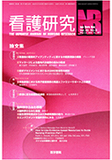Japanese
English
- 有料閲覧
- Abstract 文献概要
- 1ページ目 Look Inside
看護研究はその成果が臨床実践に活用されてこそ,その価値は高まるといえよう。ここでは,カナダのMcMaster大学に籍を置くDonald氏,Evidence-Based Nursingの第一人者で本文中にも出てくる『Evidence-Based Nursing』誌の編集委員も務めるDr. DiCenso氏に,EBNの大切な要素の1つである「エビデンスを使う」に焦点をあててもらった。シナリオを用いて具体的かつ非常にわかりやすく研究を実践に適用するプロセスとそこで必要となる知識を指し示してくれるが,そこから研究成果を生み出す側として留意すべき点を読み取ることもできるだろう。次号と2回に分けて掲載する。
When deciding whether to implement new programs or clinical interventions, nurses are increasingly required to provide evidence of favourable patient outcomes and costeffectiveness. Finding the best evidence has traditionally been a difficult process and has been left to nurses and other health care professionals who have advanced education and skills in the critique of research studies. The international interest in evidencebased nursing has stimulated the production of a number of high quality and readily available resources for nurses to use when searching for evidence. These resources use built-in methodological filters to identify scientifically sound research which make it possible for all nurses to be evidence-based practitioners even if they do not have advanced education or skills in critique of research studies. In a 2-part series, we illustrate how these evidence-based resources can be used to guide nursing practice. In Part 1, in this article, we present a clinical scenario and review types of research questions and levels of evidence that provide the foundation for use of evidence-based resources. In Part 2, in the next issue of this journal, we address the problem presented in the clinical scenario by taking readers through the formulation of a focused question, the search strategy for locating high quality evidence, the consideration of clinical applicability of the research findings, and strategies to overcome organizational barriers to evidence-based changes in clinical practice.

Copyright © 2002, Igaku-Shoin Ltd. All rights reserved.


